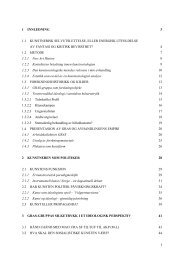2003 Rogaland museum - Gras Katalog - Victor Lind
2003 Rogaland museum - Gras Katalog - Victor Lind
2003 Rogaland museum - Gras Katalog - Victor Lind
You also want an ePaper? Increase the reach of your titles
YUMPU automatically turns print PDFs into web optimized ePapers that Google loves.
a stylised blond nude in a side/frontal position while, in sharp contrast, the lower<br />
section is filled by the photographic image of an Afro-American woman faced down<br />
on the pavement, a victim of the race riots in Newark in 1967. The idealised and the<br />
real, art and reality, Krohg composed an image that could all but take the skeletons<br />
of contemporary society lightly.<br />
The difference, then, between GRAS and Pop art seems to insist on being<br />
an iconographical one – not a stylistic one. Art history has other examples of that<br />
type of difference; however, the most relevant for the purpose at hand here can be<br />
found in Robert Rosenblum’s 1965 distinction between Pop art and that which he<br />
defined as Non-pop art. Non-pop art was simply that which attended to the stylistic<br />
elements of Pop art, but which did not speak the same aesthetic language; Pop art<br />
called on an exulting of the commonplace in the work, using the visual vocabulary<br />
of mass production, while Non-pop did not. Rosenblum held that Lichtenstein,<br />
Warhol, and Wesselmann were Pop artists, while Rauschenberg, Jasper Johns, and<br />
Jim Dine were not. What is interesting here, however, is when Rosenblum argues<br />
that although they are very different with regards to their iconographical value, the<br />
style employed by both was in sharp opposition to those venerable humanistic traditions<br />
that the aesthetic values of the 1950s would have defended. “So obtrusive,”<br />
Rosenblum continues, “was the subject matter of Lichtenstein’s or Warhol’s first<br />
Pop paintings that spectators found it impossible to see the abstract forest for the<br />
vulgar trees.” That abstract value is thus of importance and, what more, in this context<br />
it is an interesting idea that justifies further insight.<br />
Two points can be drawn out of this comparison. Firstly, attending to<br />
Rosenblum’s distinction between Pop and Non-Pop art, a similar type of distinction<br />
may be found in Pop and GRAS; iconographically they differ, stylistically they do<br />
not. A further specification concerning Pop art can be offered here; New York Pop<br />
art intensified Rauschenberg’s critique of Abstract Expressionism’s relentless interiority<br />
through cool impersonality, and by the mid 1960s, Warhol’s work was also<br />
in dialog with contemporary abstract and minimalist works. Accepting this, the gulf<br />
dividing Pop art and abstract art no longer seems as unbridgeable as one would<br />
immediately think. Hard Edge abstractionists are not, in other words, as distinct<br />
from their Pop art counterparts as the comparison would first imply. The range of<br />
artistic form fronted by GRAS loses, thus, some of its awkwardness and the sense<br />
of the unity of the group is intensified.<br />
Secondly, accepting that the common distinction uniting Pop art and Non-<br />
18



